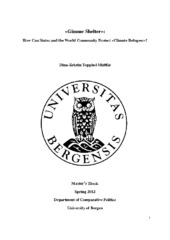| dc.description.abstract | The aim of this paper is to look at how the world community can offer protection to climate refugees". Although migration in the face of natural or human made disasters is not a new trend, there are signs of increases in natural disasters, and further, estimations of a high number of people being forced to move due to the effects of climate change. Today, there is no international regime for the protection of those who are forced to flee due to the effects of environmental or climate change. The research question is therefore: How can states and the world community protect climate refugees"? To figure out how climate refugees" can best be protected the paper first looks at definitions of climate refugees" and terms linked to this concept, environmental refugee", climate migrant" and environmental migrant", in academic texts. There currently exist no universal definitions of these terms, and the thesis shows how different terms are used in the same context. I use the definitions of the terms and the typology of forced versus voluntary migration to show how the terms could be defined based on why people are moving (effects of climate change or environmental change), whether or not the movement is internal or cross-border, and the extent of force involved in the movement. As there are no protection mechanisms for people forced to move cross state borders due to climate or environmental change, it could be argued that there is a human rights gap". On the other hand, population movement can lead to sovereignty issues. Human rights and sovereignty are discussed, in relation to each other, in relation to migration/population movement and in relation to climate change. This discussion is used to evaluate the proposed alternatives for protection mechanisms for persons that have to move due to the effects of climate change. The thesis presents a broad range of proposed alternatives for protection mechanisms for people forced to move due to climate change: convention-related alternatives, regional alternatives, proportional migration, a global insurance scheme, and community relocation. It is hard to say which one would offer the best protection. The reason for this is due to the problems of generalization: the effects of climate change are not expected to be the same across the globe, and there might be needed different strategies in different regions. The generalization problem could, however, be an argument for claiming that regional alternatives could best address the issue. | en_US |
